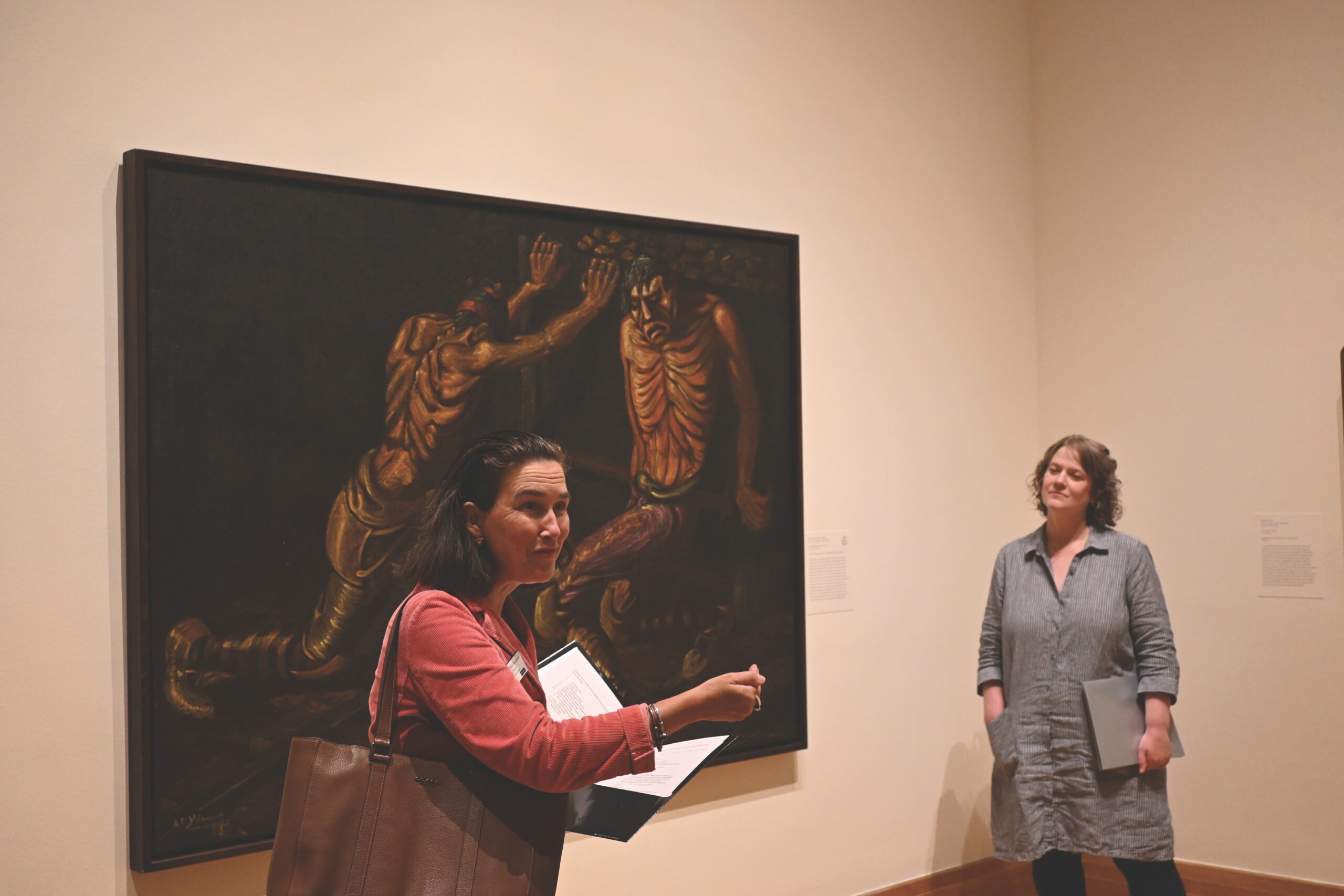BCMA adds paintings from Bolivia’s Yllanes to collection
September 27, 2024
 Thetis Fourli
Thetis FourliThe Bowdoin College Museum of Art (BCMA) recently acquired two works by the Bolivian Aymara artist Alejandro Mario Yllanes, becoming the first American museum to own one of his paintings. Museum Co-Director Anne Collins Goodyear and Curator Casey Braun hosted a gallery talk on Tuesday to discuss the significance of the recent acquisitions.
The BCMA acquired “Estaño Maldito” (Cursed Tin, 1937) and “Elegia” (Elegy, 1944) after a gallerist in London contacted Goodyear and Braun about Yllanes, a relatively obscure artist who explored the tensions between indigeneity and modernity.
“One of the things I work on with the full curatorial team is [how] we can continue to expand our collection, and sometimes that means thinking about bringing in works of art that are not currently represented in the museum,” Braun said. “Anne is a scholar of American modernism. I’m a scholar of indigenous art and Latin America. And so we’re … drawing out what is interesting from this perspective of Western modernism, where we are seeing the broader histories and cultural and political contexts of Latin America.”
The talk focused on Yllanes’s life, politics and art as a conduit for revolutionary thought. Yllanes was orphaned at a young age and forced to work in the Bolivian tin mines despite being educated in law. His experience spurred him to create art as a way to elevate the indigenous communities of the Andes, like the Aymara to which he belonged.
“He experienced firsthand the really deplorable working conditions, but really saw the way that indigenous people were being exploited by colonial governments and regimes,” Braun said. “Having a work of art or a group of works of art that address topics that might otherwise be very charged or challenging [or] difficult to talk about, offers people a way to have those conversations in a space that feels a little bit safer.”
Elsewhere in Latin America, the arts also became a conduit for the post-revolution Mexican government to promote the values of the leftist revolution, including a multitude of pieces that called attention to exploitation of the working class. These pieces inspired Yllanes in his own activist art, which circulated throughout the 1940s. However, his revolutionary works caused him to be in and out of favor with the Bolivian government. In fact, at the time that Yllanes painted “Estaño Maldito” he was in exile in Mexico.
“Because he was so well educated, he was somebody who, I think, took inspiration from the rise of print journalism [and] from the rise of journals that were beginning to circulate about modern art in Latin America,” Goodyear said.
Michele Greet ’93, a professor at George Mason University and one of the world’s leading experts on Yllanes’ career, wrote on his work as a part of the Indigenismo, or Indigenist movement in Latin America. The movement called attention to relations between indigenous peoples and their governments.
“They started to use art as a way of communicating, rather than just painting pretty pictures or paintings for elite homes,” Greet said. “They started to say, ‘We want to reveal difficult truths.’”
Unlike post-revolutionary artists in Mexico, Indigenist artists in countries like Yllanes’s Bolivia were unsupported by their governments. While Mexican revolutionary artists painted murals to educate the public, “Estaño Maldito” was painted on burlap, perhaps to be a portable mural, as burlap’s lighter weight meant that it could be more easily transported. “Eligia” as a print is also uniquely positioned to be a vehicle for social and political messaging because it can be cheaply reproduced at high volumes.
“Estaño Maldito” was chosen to be shown in Mexico City at an exhibition organized by Diego Rivera at the Palace of Fine Arts in the 1940s. Its presence at an international exhibition made the realities of Bolivian mining apparent to an international audience.
Carrying its relevance into the present day, Assistant Professor of Government Túlio Zille believes that Yllanes’s work can enrich various courses that deal with concepts of indigeneity, environmental studies and the exploitation of the human body.
“[‘Estaño Maldito’] is also quite contemporary given ongoing exploitation of minerals in Latin America, which is only worsening due to a rising demand for minerals used in transitions to ‘clean’ energy,” Zille wrote in an email to the Orient.
Similarly, Professor of Romance Languages and Literatures Carolyn Wolfenzon Niego found that art can humanize the topics her students read or talk about in class. A painting is able to convey and personalize the story that students are learning about in a more accessible way.
“[It is] important for [my students] to see many of the topics that we have talked or read about, to see it in a picture or see it in a photograph or in a sculpture,” Niego said. “It’s easier to explain in literature what they are seeing on paint.”
Yllanes mysteriously disappeared around the time that he received—but refused to accept—a Guggenheim Fellowship and faded into relative obscurity. However, Goodyear found that the value of Yllanes’s work lies in its legacy.
“He did make a dent in the world with his art while he was able to do so, and now I feel like the job of our generation is to pick up the fragments with which he has left us,” Goodyear said. “It’s really exciting to me that through this acquisition, we can shine light on somebody who hasn’t yet been brought into the canon.”

Comments
Before submitting a comment, please review our comment policy. Some key points from the policy: